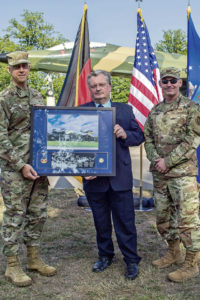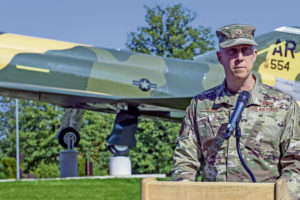
Leadership recognized the accomplishments of the 86th Maintenance Group and 86th Civil Engineer Group in refurbishing an RF-4C Phantom II aircraft at Ramstein Air Base, Sept. 17.
Brig. Gen. Josh Olson, 86th Airlift Wing commander, along with Col. Christopher B. Meeker, 86th CEG commander, and Col. Anthony M. Nance, 86th MXG commander, presented plaques to each organization for their work on the 5-year project.
“Today not only recognizes a combination of years of hard work for many of you in the audience, but even more so, four decades of rich fighter heritage and legacy that Ramstein is known for,” Olson said.
The RF-4C, a tactical reconnaissance aircraft, was used by the U.S. Air Force in operations during the Vietnam War, Cold War and Desert Storm. This particular aircraft, tail number 68-0554, now on display at the Northside Fitness Center traffic circle, spent its entire operational life with units assigned to U.S. Air Forces in Europe.
“The aircraft you can see here, was decommissioned in 1991, sitting in an old French shelter on the southwest side of the base with only a few people aware of its existence,” said Andreas H. May, 86th Civil Engineer Squadron chief engineer.
In 2015, May talked to the USAFE historian about an idea to restore and display the RF-4C. A year later, May and the historian, along with the 86th Maintenance Squadron, developed a decision brief for the 86th AW commander, outlining a refurbishment plan.
“On the engineering side, I took a personal interest and started working on the design for the foundation and stands, structural calculation, programming and certainly the budget for the construction project,” May said.
Once the aircraft was moved to an 86th MXG compound, work on the restoration requirements and technical details of the aircraft’s color scheme and tail markings commenced.
“The MXG team did an amazing job and was very well coordinated,” said Staff Sgt. Jordan Smith, 86th MXS aircraft structural maintenance craftsman and a key player in painting the restored aircraft. “Structural maintenance did a lot of the refurbishment and (demilitarization) of the aircraft. Metals Tech made some parts for putting in the augmenters in the back for the exhaust, which I then installed within the aircraft. The biggest portion was Air Repair when they towed the aircraft and assisted the outside company with lifting it into position.”

Five years later, after more than 100 volunteers spent countless hours on the aircraft’s demilitarization, removal of explosives, emptying of the fuel tanks and hydraulics systems, cleaning, restoration and relocation, the project was completed.
“The efforts of this hundred-plus that worked on this whole project, made it come to reality,” said Michael Edwards, U.S. Air Forces in Europe and Air Forces Africa deputy senior political advisor and prior RF-4C weapons system officer. “Your efforts restored this aircraft back to its glory days. It’s a testament to your dedication and your professionalism, to preserve an important part of Air Force and USAFE history and heritage.”
Thanks to the tireless efforts of the 86th MXG and 86th CEG, the RF-4C, a piece of Ramstein heritage and historic monument in both German and American communities, will not be forgotten and can be observed and appreciated for years to come.


